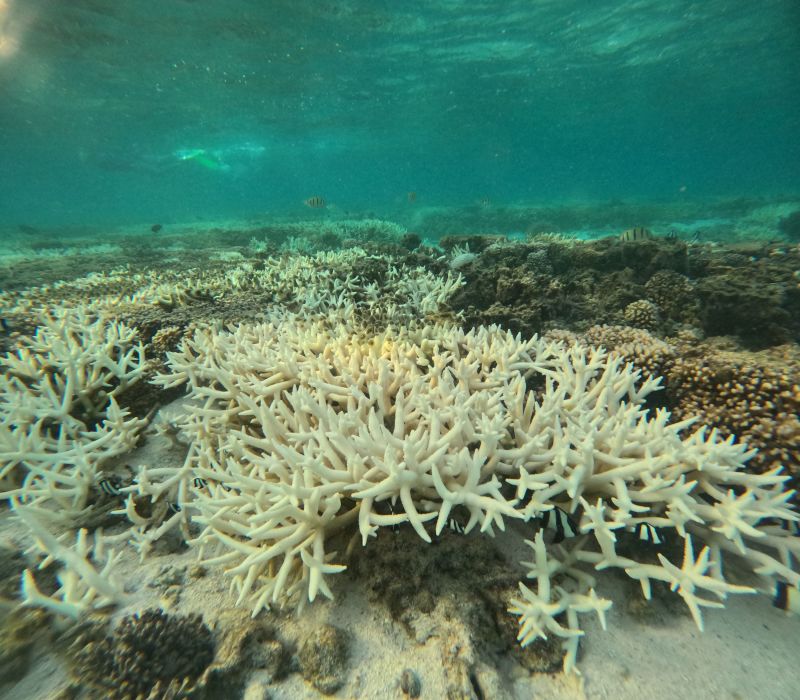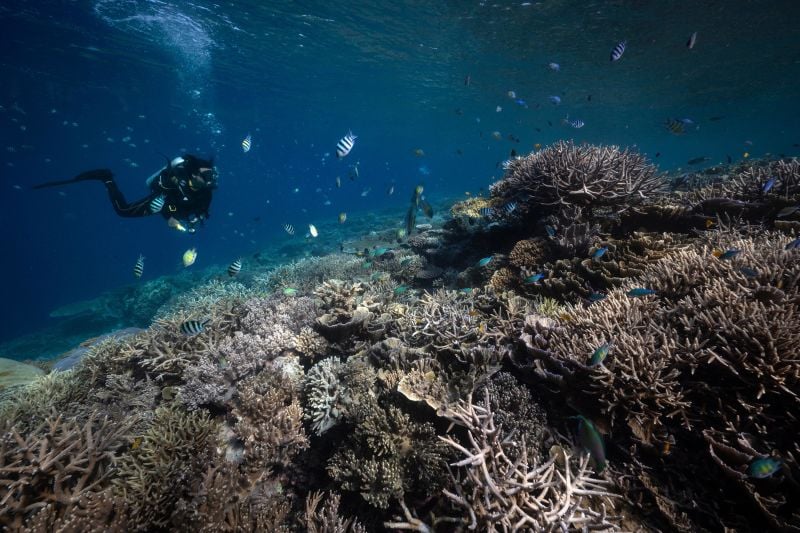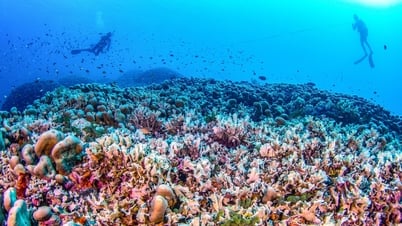More than half of the world's coral reefs are bleached
More than 54% of the world's coral reefs have suffered bleaching in the past year, affecting at least 54 countries and territories including large areas of the Atlantic, Pacific and Indian oceans, according to a joint statement from the US National Oceanic and Atmospheric Administration (NOAA) and the International Coral Reef Initiative (ICRI).
“It is likely that this bleaching event will soon surpass the previous peak of 56.1%,” said Derek Manzello, coordinator of NOAA’s Coral Reef Watch program. “The percentage of reef areas experiencing bleaching stress has increased by about 1% per week.”

Bleached corals of the Great Barrier Reef, February 19. Photo: CNN
Bleaching is triggered by water temperature fluctuations that cause the colorful algae that live in the coral's tissues to be expelled. Without the algae's help in providing nutrients to the coral, the coral cannot survive.
This is the fourth global bleaching event ever recorded in the world and the second in just the past 10 years, following previous events in 1998, 2010 and between 2014 and 2017.
Over the past year, mass coral bleaching has been confirmed in areas including Florida and the wider Caribbean, Mexico, Brazil, Australia, the South Pacific, the Red Sea, the Persian Gulf, Indonesia and the Indian Ocean including the east coast of Africa and the Seychelles.
Professor Ove Hoegh-Guldberg, a climate scientist specializing in coral reefs based at the University of Queensland in Australia, predicted this mass bleaching event months ago.
"We knew that ocean temperatures were rising rapidly, but not at this rate," he told CNN on April 15. "The worrying thing is that we don't know how long this major temperature change can last."
Many scientists have expressed concern that many of the world's coral reefs will not recover from the prolonged and intense heat. This year's global bleaching event has only added to scientists' concerns that corals are in serious danger.
The past 12 months have been the planet’s hottest on record, and ocean temperatures have hit record highs. Global sea surface temperatures hit record highs in February and again in March, according to data from the European Commission’s Copernicus Climate Change Service.
What is the role of coral?
Corals are colonies of marine invertebrates. Their calcium carbonate secretions form a hard protective shell that serves as a home to many colorful single-celled algae.
Algae and coral have evolved over millennia to coexist. The coral provides shelter for the algae, while the algae remove the coral's waste products and return energy and oxygen to their host.

Divers swim through bleached coral reefs in the waters of Raja Ampat Regency in West Papua, eastern Indonesia. Photo: AFP
Coral reefs cover less than 1% of the ocean floor but provide huge benefits to marine ecosystems. 25% of marine life depends on coral reefs for shelter, food or reproduction. Coastal fisheries would struggle without corals.
Coral reefs also contribute significantly to the marine economy. According to a 2020 estimate by the Global Coral Reef Monitoring Network (GCRMN), coral reefs provide an estimated $2.7 trillion in goods and services annually, ranging from tourism to coastal protection. About $36 billion is generated by coral diving tourism.
Coral reefs also help coastal communities by forming a protective barrier against storm surges and large waves, which has prevented property damage for more than 5 million people worldwide, according to a 2022 study in the journal Marine Policy.
What can be done to save bleached coral reefs?
Corals can survive bleaching events if the surrounding waters cool and algae return. Scientists at the Palau International Coral Reef Center estimate that it takes at least nine to 12 years for coral reefs to fully recover from mass bleaching events, according to research published in 2019.
The best chance for coral survival is for the world to cut greenhouse gas emissions to limit climate change. Many scientists say that if temperatures rise just 1.2 degrees Celsius above pre-industrial levels, the world will have passed a critical threshold for coral reef survival. They expect between 70% and 90% of the world’s coral reefs to disappear.
Local communities need to implement programs to clean up trash from coral reefs. Scientists are breeding corals in the lab in hopes of restoring degraded reefs.
None of these measures, however, will protect today’s corals from warming waters, so scientists are trying to plan for the future by placing coral larvae in cryopreservation banks and breeding hardier corals.
Ecologist David Obura, head of CORDIO East Africa, an organization that supports the sustainability of coral reefs and marine systems, said while these measures are important, breeding genetically modified corals is not the answer to climate change.
“We have to be very careful about claiming it’s the solution and that it’s saving the reefs now. The reefs won’t recover until we reduce carbon emissions,” he said.
Hoai Phuong (according to CNN, Reuters)
Source




































![[Photo] General Secretary To Lam begins official visit to Russia and attends the 80th Anniversary of Victory over Fascism](https://vphoto.vietnam.vn/thumb/1200x675/vietnam/resource/IMAGE/2025/5/8/5d2566d7f67d4a1e9b88bc677831ec9d)
![[Photo] Prime Minister Pham Minh Chinh meets with the Policy Advisory Council on Private Economic Development](https://vphoto.vietnam.vn/thumb/1200x675/vietnam/resource/IMAGE/2025/5/8/387da60b85cc489ab2aed8442fc3b14a)


































































Comment (0)